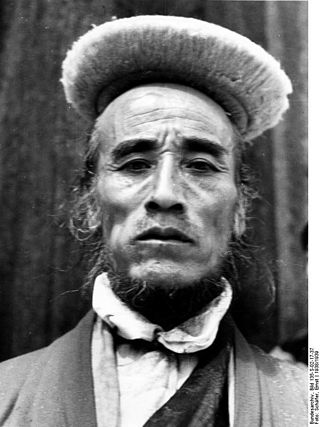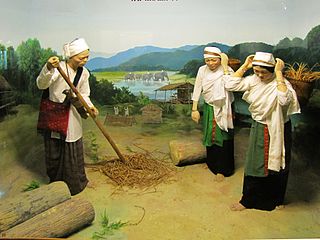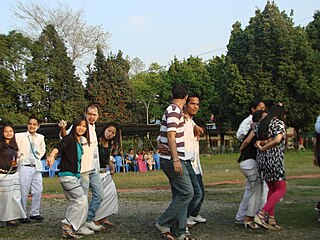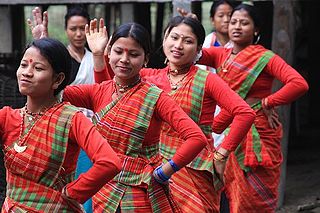
Mājuli or Majuli is a large river island located in Assam, India. It is formed by the Brahmaputra River to the south and east, the Subansiri River to the west and an anabranch of the Brahmaputra River called Kherkutia Xuti to the North.

Nyishi community is the largest ethnic group in Arunachal Pradesh in north-eastern India. The Nyishi language belongs to the Sino-Tibetan family, however, the origin is disputed. Their population of around 300,000 makes them the most populous tribe of Arunachal Pradesh, closely followed by the tribes of the Adi according to 2001 census.

Bhotiya or Bhot is an Indian and Nepali exonym lumping together various ethnic groups speaking Tibetic languages, as well as some groups speaking other Tibeto-Burman languages living in the Transhimalayan region that divides India from Tibet. The word Bhotiya comes from the classical Tibetan name for Tibet, བོད, bod. The Bhotiya speak numerous languages including Ladakhi. The Indian recognition of such language is Bhoti / Bhotia having Tibetan scripts and it lies in the Parliament of India to become one of the official languages through Eighth Schedule of the Indian Constitution.

The Tangshang people or Tangsa Naga, are of Tibeto-Burmese ethnic group of the Arunachal Pradesh and Assam. They also reside in Sagaing Region and parts of Kachin State of Myanmar. In Myanmar they were formerly known as Rangpang, Pangmi, and Haimi. They speak their own language Tangsa.

Chhaang or chhyang is a Nepalese and Tibetan alcoholic beverage also popular in parts of the eastern Himalayas, Yakkha, Limbu, Dura, Newar, Sunuwar, Rai, Gurung, Magar, Sherpa, Tamang, Tharus and Lepcha communities. Among the Lepcha, it is called Chi. It is also known as jaarh in Nepal.

Assamese cuisine is the cuisine of the Indian state of Assam. It is a style of cooking that is a confluence of cooking habits of the hills that favour fermentation and drying as forms of preservation and those from the plains that provide extremely wide variety of fresh vegetables and greens, and an abundance of fish and meat. Both are centred on the main ingredient — rice. It is a mixture of different indigenous styles with considerable regional variations and some external influences. The traditional way of cooking and the cuisine of Assam is very similar to South-East Asian countries such as Thailand, Burma (Myanmar) and others. The cuisine is characterized by very little use of spices, little cooking over fire, and strong flavours due mainly to the use of endemic exotic fruits and vegetables that are either fresh, dried or fermented. Fish is widely used, and birds like duck, pigeon, squab, etc. are very popular, which are often paired with a main vegetable or ingredient; beef used to be eaten before British colonialism, and some continue to do so. Preparations are rarely elaborate. The practice of bhuna, the gentle frying of spices before the addition of the main ingredients so common in Indian cooking, is absent in the cuisine of Assam. The preferred oil for cooking is the pungent mustard oil.

Indian breads are a wide variety of flatbreads and crêpes which are an integral part of Indian cuisine. Their variation reflects the diversity of Indian culture and food habits.

The Tai Khamti, also known as the Hkamti Shan or simply as Khamti, are a Tai ethnic group of India, China and Myanmar. The Tai-Khamti are followers of Theravada Buddhism. The Tai-Khamti have their own script for their language, known as 'Lik Tai', which originated from the Shan (Tai) script of Myanmar. Their mother tongue is known as Khamti language. It is a Tai language, closely related to Thai and Lao.

Magh Bihu (also called Bhogali Bihu or Maghar Domahi is a harvest festival celebrated in Assam, North-East India, which marks the end of harvesting season in the month of Magh. A bonfire is lit for the ceremonial conclusion and prayer to the God of Fire. The festival is a regional variance of Makar Sankranti.
Bora saul is a variety of glutinous rice found in Assam, India. It has an important role in Assam and for indigenous Assamese. During traditional occasions like Bihu, this variety of rice is eaten with served with doi (curd), gur (jaggery) and cream.
Jonai is a subdivision of Dhemaji District in India's Assam State.

Handia is a rice beer originating from the Indian subcontinent, popular in the Indian states of Assam, Jharkhand, Bihar, Odisha, Madhya Pradesh, Chhattisgarh and West Bengal.
Kulajan Tiniali is a town in Dhemaji district in the Indian state of Assam. The town is situated on the northern bank of the Brahmaputra River, and is located approximately 493 kilometres from the city of Guwahati and just 13 km from Arunachal Pradesh. National Highway 15B starts at Kulajan and connects it to Dibrugarh.
The type of the dishes of the Indian state of Arunachal Pradesh vary within the region, according to tribal influence

The 'Mopin' or 'Moopin' Festival is an agricultural festival celebrated by the Galo tribe of Arunachal Pradesh, India in particular of the Galo group of tribes which resides in East Siang and West Siang districts. It is a celebration of the harvesting season held in the Galo months of "Lumi" and "Luki", corresponding to March–April and the new year for the Galo tribe. The Galo tribe follow an animist religion called Donyi-Polo.

Ali-Aye-Ligang or Ali-Ai-Ligang a spring festivity associated with agriculture celebrated by the Mising or Mishing tribal people of Assam and other Northeast indian states on the occasion of the beginning of the Ahu paddy cultivation. The festival marks onset of sowing seeds. The name of the festival is made up of three terms, "Ali", legumes, "Aye", seed and "Ligang", to sow.

The Mising people are a Sino-Tibetan ethnic group inhabiting mostly in the Northeast Indian states of Assam and Arunachal Pradesh. They are part of the greater Tani group of people of India and Tibet Autonomous Region of China.

Huangjiu is a type of Chinese rice wine most popular in the Jiangnan area. Huangjiu is brewed by mixing steamed grains including rice, glutinous rice or millet with qū as starter culture, followed by saccharification and fermentation at around 13–18 °C (55–64 °F) for fortnights. Its alcohol content is typically 8% to 20%.

Judima is a traditional ethnic rice wine associated with the Dimasa people of Assam. It has received a geographical indication tag in 2021. It is prepared from a starter kit, and is distinguished by the use of a wild herb local to Dima Hasao district called thembra. It is used ritualistically by the Dimasa people in events such as birth, marriage and death.
















